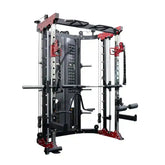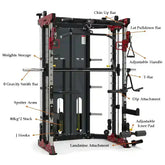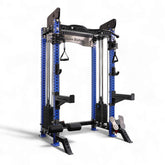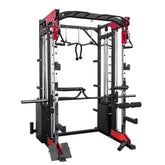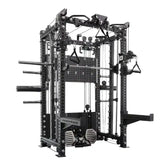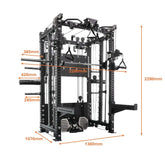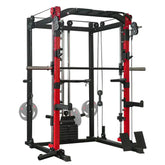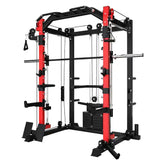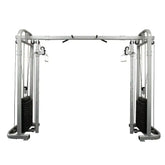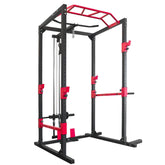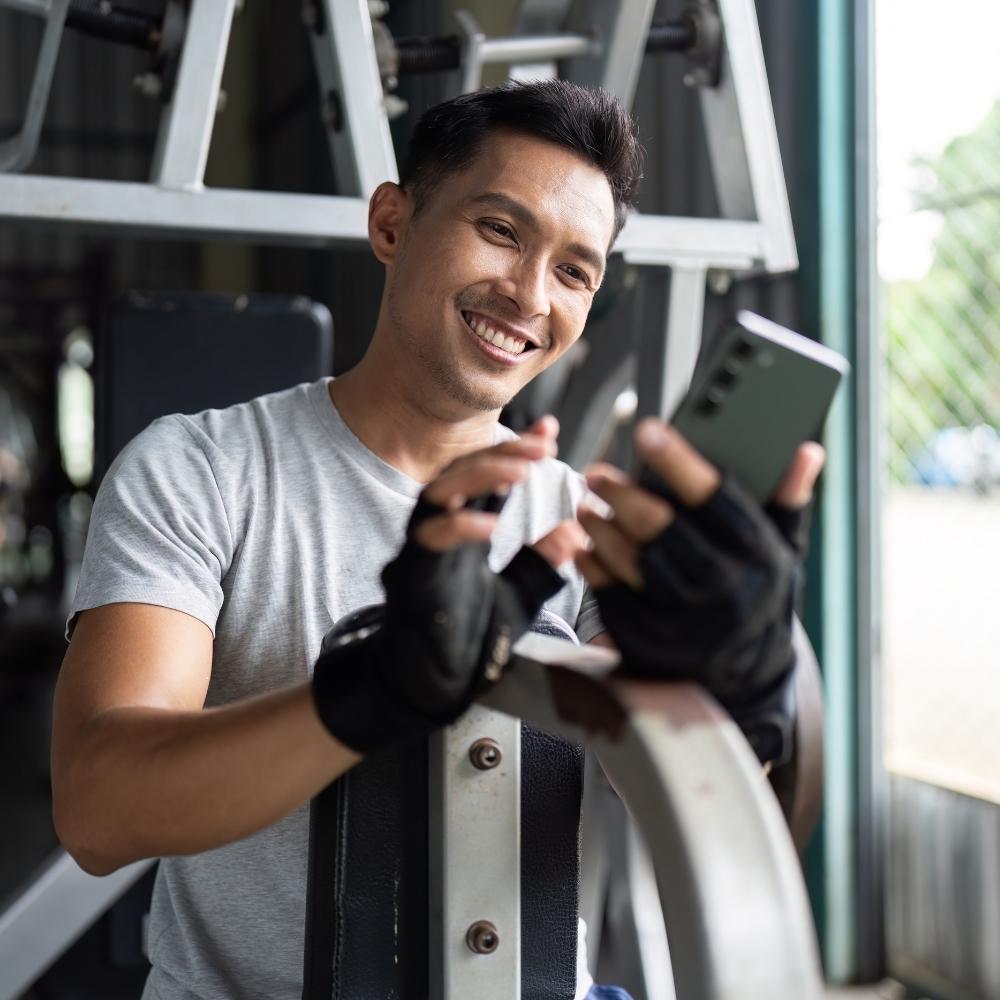Leg Press Machine Workouts: Step-by-Step Guide to Building Powerful Quads and Glutes
The leg press machine helps you build powerful quads and glutes safely by allowing you to train with heavy resistance in a stable, controlled position. Master proper form, progressive overload, and recovery to grow strong, balanced legs that combine size, performance, and mobility.
Build massive quads and glutes with the leg press machine — lift heavy safely, train with control, and fuel recovery for unstoppable leg power.
Why the Leg Press Machine Belongs in Every Serious Gym
When I competed, leg day was all about intensity — high volume, focus, and zero shortcuts.
But one piece of equipment consistently helped me break through plateaus and develop strong, balanced legs: the leg press machine.

It’s often dismissed as a “lazy” alternative to squats — but that’s a myth.
The leg press allows you to:
-
Target your quads and glutes directly
-
Train under heavier resistance safely
-
Refine technique while reducing spinal load and stress
Now, as a coach, I use it to teach athletes and lifters how to build power with precision.
If you’re setting up your home gym, this machine is a must-have for leg strength, longevity, and consistent progress.
Understanding How the Leg Press Builds Muscle
The leg press machine moves on a guided track, supporting your back while isolating the lower body for safe, controlled strength training.
Here’s how it targets key muscle groups:
-
Quadriceps (front thighs): The main drivers of the press.
-
Glutes: Activated deeply when your feet are placed higher on the platform.
-
Hamstrings: Engage to control the lowering phase and protect the knees.
-
Calves and Core: Stabilise and balance each rep through the full range of motion.
Because the machine removes balance limitations, you can focus entirely on form, range, and muscle tension — the trifecta for effective, long-term muscle growth.
Step-by-Step: Perfecting Your Form
Proper technique turns a good leg press into a growth powerhouse. Make every rep count:
-
Adjust Your Seat
Set the backrest so your hips can comfortably bend to ~90–100°.
Too close and your hips may posteriorly tilt off the pad; too far and you’ll lose depth.
-
Set Foot Placement for Your Goal
Foot position changes the training emphasis:
-
Low & Narrow: Quad focus for front-thigh sweep.
-
High & Wide: More glutes and hamstrings for power.
-
Shoulder-Width: Balanced overall leg development.
Coach’s Tip: Rotate stances every few weeks to hit all angles and keep progress moving.
-
Control the Descent
Lower the sled on a 3-second count until knees pass ~90° (without hips rolling). Keep your lower back glued to the pad to protect your spine.
-
Drive Through Your Heels
Press up under control and keep constant tension. Avoid locking the knees at the top — think “soft lock” and stay in the muscles.
-
Lock In the Mind–Muscle Connection
Actively contract quads and glutes through the whole range. Every rep is deliberate — don’t just move weight; move with intent.
Building Quads Like a Pro
Thick, powerful quads aren’t luck — they’re the result of controlled overload and consistent technique performed with precision.
My Go-To Quad Routine on the Leg Press:
-
Leg Press (Low Foot Placement): 4 sets × 10–12 reps
-
Single-Leg Press: 3 sets × 8–10 reps per leg
-
Quad Pulse Presses (Short Range): 2 sets × 20 reps — a high-burn finisher
Coach’s Cue: Keep your hips glued to the pad and drive evenly through your feet.
You should feel the burn in your quads, not your lower back.
The secret is time under tension. Control the eccentric (downward) phase — that’s where the real muscle-building magic happens.
Sculpting Strong, Athletic Glutes
Your glutes are the powerhouse of your body — essential for athletic performance, posture, and overall aesthetics. Here’s how to use the leg press to build them effectively and safely:
-
High Foot Placement: Shifts emphasis to the glutes and hamstrings.
-
Slow Eccentric Phase: Lower the sled slowly to create a deep, controlled stretch.
-
Pause at the Bottom: Hold for one second to activate more muscle fibres.
-
Explosive Drive Up: Push through your heels and squeeze hard at the top.
For complete lower-body development, pair your leg press glute work with Smith machine hip thrusts or dumbbell Romanian deadlifts — both excellent for reinforcing power and symmetry.
Coach’s Insight: You can’t build strong glutes with half reps. Go deep, control the tempo, and train through the full range of motion for maximum growth and performance.
Progressive Overload: The Secret to Growth
The biggest mistake I see on the leg press? Loading it too fast and losing form.
Muscles grow through progression — not ego.
Follow this simple rule for steady, safe results:
-
Start with a weight you can handle for 10–12 clean reps.
-
Add 2.5–5 kg per side each week — but only if your form stays perfect.
-
Alternate between heavy weeks (6–8 reps) and volume weeks (15–20 reps).
-
Track every session — even small progress adds up over time.
Progressive overload isn’t about chasing numbers — it’s about consistency, control, and patience. That’s how real leg mass and strength are built.
How to Program the Leg Press into Your Routine
The leg press machine fits seamlessly into any leg-focused or full-body training schedule.
Here’s a sample weekly layout I use with intermediate athletes to build both strength and endurance while protecting the joints:
|
Day |
Focus |
Key Exercises |
|
Monday |
Heavy Leg Power |
Squat Rack, Leg Press, Smith Lunges |
|
Wednesday |
Upper Body |
Dumbbell Bench Press, Cable Rows |
|
Friday |
Volume Legs |
Leg Press (High-Rep), Romanian Deadlift, Step-Ups |
|
Sunday |
Recovery |
Foam Rolling, Light Cycling, Pilates Reformer |
This combination of heavy and volume sessions develops muscle density, strength, and endurance — all while promoting healthy joints and balanced recovery.
Recovery: Where Growth Actually Happens
Leg training demands recovery like no other. After a tough session, your muscles need time, nutrients, and mobility to rebuild stronger and more resilient.
1. Prioritise Mobility
Tight quads and hips can limit your squat depth and form. Spend 10 minutes post-workout stretching or using a foam roller on your quads, hamstrings, and calves to improve flexibility and reduce soreness.
2. Hydrate Strategically
Dehydration leads to stiffness and slower recovery. Aim for at least 3 litres of water daily, and consider adding electrolytes after intense training to replace lost minerals and support muscle function.
3. Eat for Growth
After training, fuel your body with a balanced meal rich in:
-
Lean protein (chicken, eggs, tofu, or fish)
-
Complex carbs (rice, oats, or sweet potato)
Your muscles rebuild when you feed them — not just when you rest.
4. Sleep Like It’s Training
Sleep is where recovery truly happens. During deep rest, growth hormone peaks, driving repair and muscle growth. Aim for 7–8 hours of quality sleep each night to amplify recovery and performance.
Coach’s Note: Training hard creates the stimulus — but nutrition, sleep, and mobility deliver the results. Respect the process, and your body will reward you with lasting strength and progress.
The Nutrition Philosophy That Changed My Results
As a bodybuilder, I used to think nutrition was just about macros and meal timing.
But over time, I realised it’s much more than that — it’s about fueling your body to perform, recover, and stay consistent.
I teach every athlete I coach to build their nutrition around three simple principles:
-
Whole Foods First: Choose real, nutrient-dense foods — less packaging, more nourishment.
-
Consistent Meal Patterns: Your body thrives on rhythm. Eat regularly to maintain energy and support recovery.
-
Smart Indulgence: Enjoy food without guilt. Health isn’t perfection — it’s balance and sustainability.
When you start treating food as fuel instead of restriction, your energy, recovery, and motivation reach new levels — both in the gym and in life.
Integrating the Leg Press into Your Home Gym

If you’re building a home gym, the leg press machine is your ultimate lower-body companion.
It complements other Alpha Go Fitness essentials designed for balanced, high-performance training:
-
Squat Rack: For open-bar compound lifts and full range-of-motion power work.
-
Smith Machine: For safe, controlled isolation movements and glute-focused training.
-
Dumbbell Set: For step-ups, lunges, and accessory exercises that refine strength and balance.
Together, these pieces create a versatile, professional-grade setup for complete lower-body development — right from your garage, studio, or training space.
Explore Home Gym Packages at Alpha Go Fitness — crafted for performance, safety, and long-term results.
Common Mistakes to Avoid
Even experienced lifters can make simple errors on the leg press that limit results or increase joint stress.
Avoid these to protect your progress — and your knees:
-
Locking your knees: Always keep a slight bend at the top to maintain tension and protect the joints.
-
Shallow range: Lower deep enough to feel a full stretch in your glutes and quads — depth builds muscle safely.
-
Rushing reps: A controlled tempo increases muscle activation and reduces injury risk.
-
Overloading too early: Prioritise form before weight — progress comes from control, not ego.
Coach’s Note: Perfect reps beat heavy reps every time. Respect the technique, and your strength will follow.
Final Thoughts from the Coach
When I coach athletes today, I always remind them: strong legs build strong bodies. The leg press machine allows you to lift heavy, train safely, and target your lower body with precision and confidence.
It’s one of the few machines that rewards consistency with visible, measurable results — the more control you have, the faster you grow.
Train hard. Eat well. Recover fully.
That’s the foundation of muscle, performance, and health that lasts.
Start checking your equipment here or contact us now.
Frequently Asked Questions
Can I replace squats with the leg press?
Not entirely — but it’s a great complement. Squats develop coordination and balance, while the leg press builds safe strength and muscle volume under controlled resistance.
How deep should I go?
Aim for at least 90° at the knees, and go deeper if flexibility allows — but never let your hips lift off the pad to protect your spine and maintain form.
How often should I train legs?
2–3 times per week is ideal for most lifters. Alternate heavy and high-volume sessions for complete lower-body development.
What’s a good rep range for growth?
8–12 reps for hypertrophy and strength. 15–20 reps for endurance, tone, and muscle definition.

